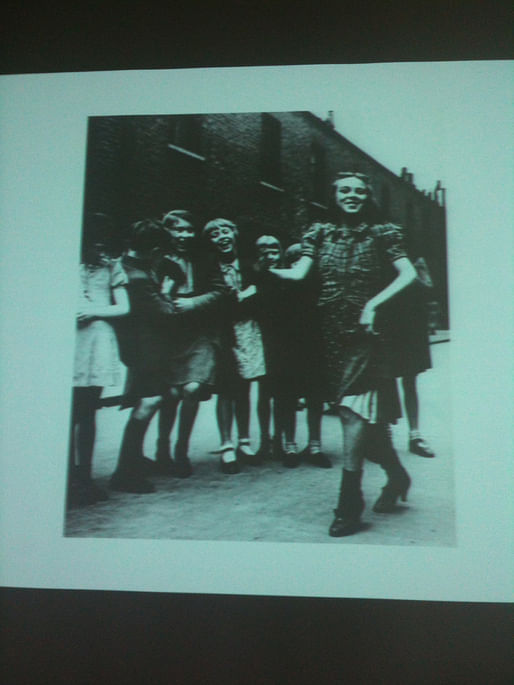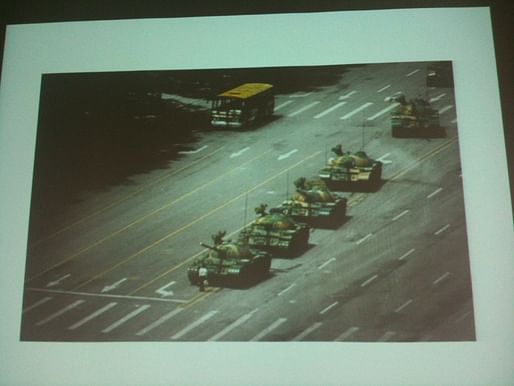
Hi Archinect!
George Baird is giving a lunchtime lecture today, hosted by the student groups CanadaGSD and LandGSD. Baird is the former Dean (2004-2009) of the John H. Daniels Faculty of Architecture, Landscape, and Design, and is a partner in the Toronto-based architecture and urban design firm Baird Sampson Neuert Architects. Prior to that, Baird was a GSD professor.
12:10: MLAII student Fadi Masoud makes the introductions. George Baird opens with some thoughts on the GSD and the University of Toronto: the University of Toronto has been criticized as being "too Harvard" in its selection of faculty, but now he has heard it mentioned that the GSD is "too Toronto"--so maybe Toronto is having its revenge.
12:20: Baird will be discussing some ideas from his book Public Space: \Cultural/Political Theory; Street Photography. He opens with Water Benjamin's notion of "distraction" and Arendt's notion of "action." On distraction: most of us, most of the time, do not pay attention to the form of architecture and urban spaces; we focus on other things. Street photography is related, for Baird, because we catch people in this kind of distraction.
12:27: The lecture comprises a walk through much of the street photography in Baird's book. [Note: I didn't always manage to catch the name of the photographer, but most of the photos are included in Baird's book and would of course be credited there.] In an aside, Baird comments that Henri Cartier-Bresson was so good at street photography that he almost stopped the practice; what could others do after him?
Arendt defines "seeing and being seen" as one of the definitions of publicness. He shows a Cartier-Bresson photograph in which an older woman looks disapprovingly at a young woman wearing a mini-skirt sitting next to her in a cafe.
For Arendt, speech is a state that is more aware than an absolute state of distraction. Georg Simmel's notion of sociability is again, a bit more aware.
The possibility of the erotic in the public realm:

Performativity is another possibility. The girl in this photo is performing, her friends are watching and enjoying, and she knows that they're watching and enjoying; this is a simple and spontaneous manifestation of performance:

Less spontaneous: the crowd. The propensity of crowds to get bigger, because passersby will slow down to see what's going on. And the nature of bodies in space changes in a crowd; you can stand closer to strangers than would normally be permitted:

Walker Evans photograph of a parade. Once you're in the crowd, social options that wouldn't otherwise exist become available. Some people in the parade-watching crowd are not watching the parade at all, but engaging in conversation with each other:

The highest form of publicness for Arendt is political speech. A Walker Evans photograph from 1929, showing a labor organizer making a case to other workers:

A photograph by the Canadian artist Jeff Wall. Wall's pieces are not street photographs in the traditional sense as most of them are highly staged. But this one is not staged: a Salvation Army officer makes a pitch to a passerby:
Baird doesn't have photos of Tahrir Square in his book because it happened too late for inclusion, but he mentions it. Instead he shows political marches related to AIDS awareness and gay rights. Photograph of a protester being arrested and taken away. Is this a form of political violence? One could argue, Baird suggests, that there is a delicate reciprocity between the politics and the performance, since having a certain number of arrests helps to define the protest.

Now a photo from Toronto, during the time of the Rodney King riots. Black protesters approached city hall and policemen were on horseback. Here we have Arendt's notion that unpredictability is a key component of action: although this incident ended peacefully, it was very uncertain at the time what would happen:

The unpredictability of action reaches its zenith in events such as in Tiananmen Square:

Public life may end in heroism, but it doesn't begin in heroism; it begins in more quotidian events that constitute the normal social and political order. More like this:
12:55: This is the argument of the book. Then there are some sections that argue that the architectural conditions of publicness are visibility, propinquity, and continuity. The book closes with some of his mixed feelings on Rem Koolhaas.
Most public spaces are too big; it's hard to create psychological intensity in spaces without boundaries. The politics of permissions about where you can protest: police forces tend to get more nervous about protests in more confined and reverberent spaces.
12:58: "I think Bill Hillier might be slightly mad." He does mathematical analyses of the events in streets, but it's particularly interesting in terms of how he analyses pedestrian movement through cities.
1:00: End of presentation. Question from Jorge Silvetti about the United States, but I can't hear the details. Baird: No claim to being the authoritative expert here, but... the phenomenon of white flight in the 50s and 60s was a huge blow to American cities. It reinforced the idea that cities were a dangerous place, and promotes excessively cautious reactions. Gated communities as part of this phenomenon. And then the recent right-ward turn of American politics. All of this works against the life of the public.
Baird: I was lured into a conference in Houston the day before I had to be in Mexico City. I went down from my hotel (The Four Seasons) onto the street at 8:30 am, and looked in every direction and could not see a single person. A few hours later, he's in Mexico City, on a cab to the center of town; a troupe of acrobats was performing in a traffic circle, with the children running between the cars as they waited at the light, to collect money.
Baird: At the end of the day I think one has to concede that New York is not really an American City.

Student comment: Terrorism on the streets is action at its most extreme or perverse, like in Delhi where I grew up.
Baird: I'm inclined to think that would be different in places like Mumbai, where that was such an exceptional event that everyone was unprepared; as opposed to, say, Pakistani cities where it's become a kind of syndrome. It's probably less shocking there because it's so recurrent.
Student: Exactly, it becomes blasé. And I was also thinking about the possibility, when you're under surveillance when you get off a plane, for someone to piece your life together (from all the pieces of information and video files).
Baird: Except that it's not always possible. Example of a recent terrorist; Washington, in all their paranoia, wasn't able to put together the information because there was too much of it.
Baird: Example of a Polish man who died in a Canadian airport recently after being tasered when he panicked and acted out. In the investigations, someone had recorded the whole episode, and this conclusively demonstrated to the commission that the four police officers had colluded in their testimony and had lied. So that's surveillance the other way around. So, it's complex and I don't have an absolute position on surveillance.
End. Applause.
Thanks for reading!
Lian
This blog was most active from 2009-2013. Writing about my experiences and life at Harvard GSD started out as a way for me to process my experiences as an M.Arch.I student, and evolved into a record of the intellectual and cultural life of the Cambridge architecture (and to a lesser extent, design/technology) community, through live-blogs. These days, I work as a data storyteller (and blogger at Littldata.com) in San Francisco, and still post here once in a while.



No Comments
Block this user
Are you sure you want to block this user and hide all related comments throughout the site?
Archinect
This is your first comment on Archinect. Your comment will be visible once approved.